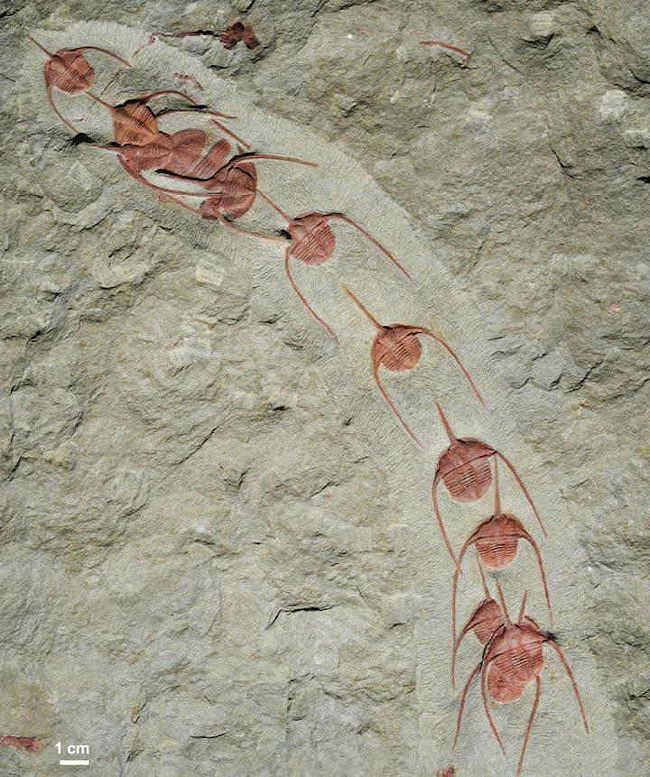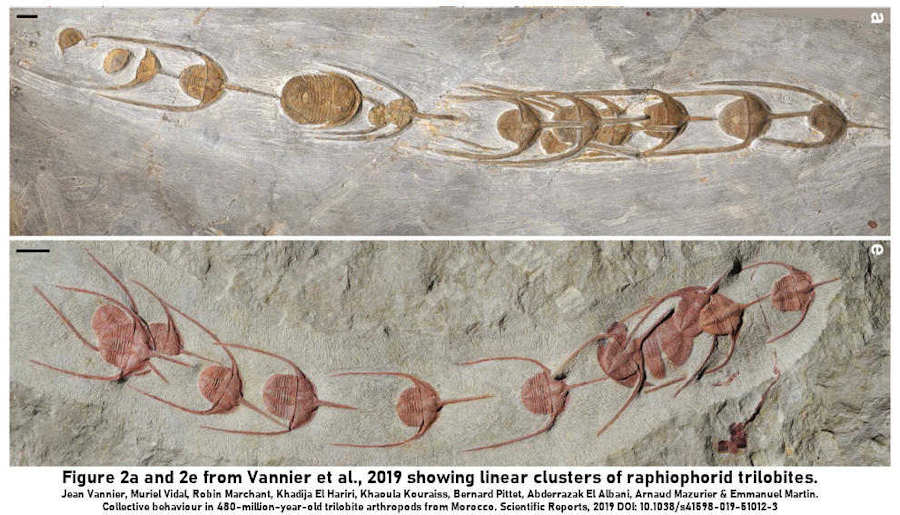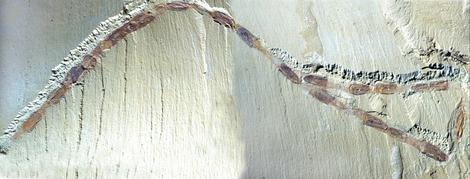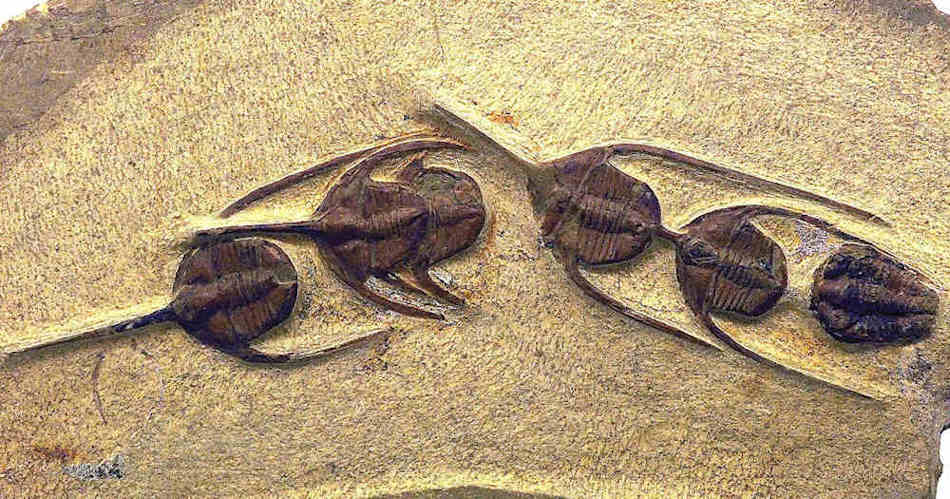Article written by: Jayson Kowinsky - Fossilguy.com
Understanding Trilobite Migration
Understanding Trilobite Migration by Looking at Ancient Relatives and Modern Crustaceans.

This is Ampyx priscus in linear formation (Moroccan Lower Ordovician Fezouata Shale) Notice an asaphid trilobite in the migration line. Image Credit: Jean Vannier, Laboratoire de Geologie de Lyon: Terre, Planetes, Environnement (CNRS / ENS de Lyon / Universite Claude Bernard Lyon 1) Fossil used in Vannier et al., 2019
Multiple instances of preserved trilobites walking in single file lines have been observed over the years. Recently, examples of this behavior have been discussed in publications. Publications include Blazejowski et al., 2016 which show Trimerocephalus chopini trilobites from the Late Devonian of Poland, and more recently, Vannier et al., 2019 which show Ampyx priscus trilobites from the Lower Ordovician of Morocco. Overall, these examples show a variety of trilobite genera over a wide range of time periods, so it appears this behavior was relatively common. Why did trilobites march and when did they start this complex behavior?
Fossils show these animals were alive and well when marching in these long lines. All indications show the trilobites were rapidly buried by some kind of sediment collapse and killed quickly. Unfortunately, it is very difficult to determine the behavior of extinct animals based solely on their fossils.
To find out why, we can look at the behavior of similar animals today. Trilobites are arthropods that belong to the crustacean class. Some modern crustaceans today do this exact same thing. A good example, as brought up by Blazejowski et al., 2016, is the seasonal migration of the Caribbean Spiny Lobsters. During fall, when the Caribbean waters get rough, these lobsters will form a long train and march toward deeper waters, out of harm's way. Making a train greatly decreases the water drag and increases their migratory speed. Also, moving in a large group adds extra safety.

This is figure 2 from Blazejowski et al., 2016 Showing A: Reconstruction of Trimerocephalus chopini in a queue. B: Short migratory queue of spiny lobsters. C: Example of T. chopini queue used in the research. Scalebar is 10 mm.
It looks like these trilobites were doing the exact same thing, possibly moving from rough waters to calmer ones. Unfortunately for the fossilized ones, they were too late. What's interesting is the oldest trilobite migration fossils date back to the Lower Ordovician (Vannier et al., 2019). This is the currently oldest occurrence of a crustacean migration.

These images show linear clusters of the trilobite Ampyx priscus from the Lower Ordovician of Morocco. Notice section a has an asaphid trilobite in the migration line. Scale bars are 1 cm. 2a and 2e have been cropped from Figure 2 of Vannier et al, 2019. Image Credit: Jean Vannier. (CC-by-sa-4.0)
Although that's the oldest occurrence of a crustacean migration, arthropods, in general, have been doing this since the beginning. As it turns out, this complex behavior was present when arthropods first appeared in the Cambrian. 525 million year old Cambrian fossils from China reveal migration chains of early arthropods (Hou et al., 2008). The research indicates these chains were probably not for feeding or reproduction, but were "possibly associated with migration" (Hou et al., 2008). The main difference between these Cambrian arthropods and the trilobite migrations is the early arthropods were assembled in the water column and sank to the bottom to fossilize, whereas the trilobites were migrating on the sea floor. Despite this, it appears that arthropods, including trilobites have been performing these complex behaviors since they first appeared in the fossil record. Vannier et al. concludes this collective behavior probably evolved through natural selection during the Cambrian radiation and then developed more extensively during the Great Ordovician Biodiversification Event (Vannier et al., 2019).

This image shows early arthropods (euarthropods) in a migration chain from the Chengjiang Lgerstatte of China, which is Early Cambrian (525 million years old). Image credit: Derek Siveter from Hou et al., 2008.
_sm.jpg)
Image of a migratory line of Ampyx preiscus trilobites with a flexicalymene also in tow. Image by Rama (CC-by-SA-3.0).
Works Cited:
Blazejowski, Blazej & Brett, Carlton & Kin, Adrian & Radwanski, Andrzej & Gruszczynski, Michal. (2016) Ancient animal migration: a case study of eyeless, dimorphic Devonian trilobites from Poland. Palaeontology. 59 (5), 743-751. https://doi.org/10.1111/pala.12252.
Xian-Guang Hou, Derek J. Siveter, Richard J. Aldridge, David J. Siveter. (2008) Collective Behavior in an Early Cambrian Arthropod. Science (New York, N.Y.). 322. 224. 10.1126/science.1162794.
Jean Vannier, Muriel Vidal, Robin Marchant, Khadija El Hariri, Khaoula Kouraiss, Bernard Pittet, Abderrazak El Albani, Arnaud Mazurier & Emmanuel Martin. (2019) Collective behaviour in 480-million-year-old trilobite arthropods from Morocco. Scientific Reports. 9, Article number: 14941. DOI: 10.1038/s41598-019-51012-3.












